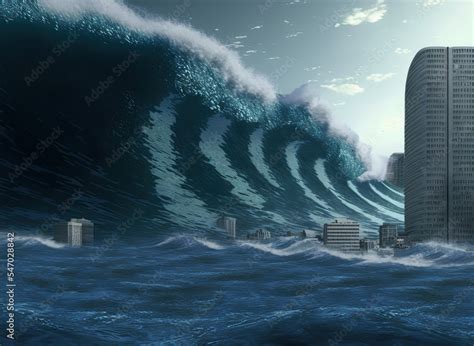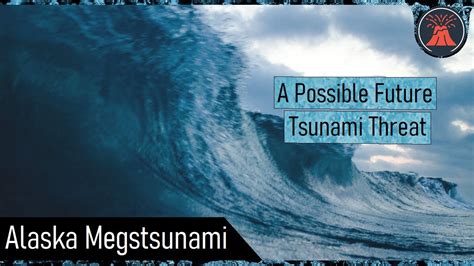
A potential mega-tsunami, triggered by a volcanic eruption on the island of La Palma in the Canary Islands, could send a 1,000-foot wave across the Atlantic, devastating the eastern seaboard of the United States, according to some scientists.
The long-dormant Cumbre Vieja volcano on La Palma is the focal point of concern, with a flank of the island potentially prone to collapse into the ocean, unleashing a massive displacement of water. While the likelihood of such an event is debated and the timing remains uncertain, the potential consequences are significant enough to warrant attention and further research, according to the original reports that resurfaced this week.
The scenario, initially explored in a 2001 study by Steven Ward and Simon Day at the University of California, Santa Cruz, posited that a substantial portion of the island’s western flank could detach and plunge into the Atlantic Ocean. This catastrophic landslide would generate a mega-tsunami, dwarfing typical tsunami events caused by earthquakes. The wave’s immense size and energy could allow it to traverse the Atlantic, impacting the coasts of North and South America, as well as parts of Europe and Africa.
While the 2001 study gained considerable attention, it also sparked debate within the scientific community. Some researchers argue that the original model overstated the potential for a single, massive landslide, suggesting that a more gradual and fragmented collapse is more likely. This would still generate a significant tsunami, but one considerably smaller and less devastating than the 1,000-foot mega-tsunami.
Despite the differing opinions on the scale of the potential event, the underlying concern remains valid: volcanic activity on La Palma poses a legitimate tsunami risk. The island has experienced eruptions in recent years, including the 2021 eruption that lasted for several months, causing widespread damage and displacement. This recent activity underscores the dynamic nature of the island and the need for ongoing monitoring and risk assessment.
The potential impact of a mega-tsunami on the U.S. East Coast is difficult to fully comprehend. A wave of that magnitude could inundate coastal communities, destroy infrastructure, and cause widespread loss of life. Cities like Miami, New York, and Boston, with their dense populations and low-lying coastal areas, would be particularly vulnerable. The economic consequences would be staggering, potentially disrupting global trade and causing trillions of dollars in damage.
The key factors influencing the size and impact of a potential tsunami include the volume of the landslide, the speed at which it enters the water, and the bathymetry (underwater topography) of the ocean floor. These factors would determine the wave’s initial height, speed, and direction, as well as how it propagates across the Atlantic.
“The specific characteristics of the landslide would have a significant impact on the tsunami’s characteristics,” said a tsunami expert not connected to the original Yahoo! article. “A slower, more fragmented collapse would generate a smaller, less energetic tsunami compared to a rapid, massive landslide.”
Ongoing research and monitoring efforts are crucial for understanding the potential risks associated with Cumbre Vieja and other volcanically active islands. Scientists are using a variety of techniques, including satellite imagery, GPS measurements, and seismic monitoring, to track the volcano’s activity and assess the stability of its flanks. Tsunami early warning systems are also in place to detect and alert coastal communities to potential threats.
While the prospect of a mega-tsunami is alarming, it’s important to note that the event is not imminent. The scientific community is actively working to refine its understanding of the risks and improve its ability to predict and prepare for potential tsunamis. Public awareness and education are also essential for ensuring that coastal communities are informed and prepared to respond to a tsunami threat.
The debate surrounding the Cumbre Vieja volcano and its potential to generate a mega-tsunami highlights the complexities of natural hazard assessment and the importance of ongoing scientific research. While the exact scale and timing of a potential event remain uncertain, the potential consequences are significant enough to warrant continued vigilance and proactive preparedness measures.
It’s crucial to differentiate between a mega-tsunami, as discussed in the original study, and more common tsunami events caused by earthquakes. Mega-tsunamis are characterized by their immense size and energy, often resulting from large-scale landslides or volcanic eruptions. Earthquake-generated tsunamis, while still devastating, are typically smaller and less energetic than mega-tsunamis.
The 2004 Indian Ocean tsunami, caused by a massive undersea earthquake, serves as a stark reminder of the destructive power of tsunamis. That event claimed the lives of hundreds of thousands of people and caused widespread devastation across multiple countries. While the Cumbre Vieja scenario involves a different type of trigger (volcanic landslide), the potential for widespread destruction is equally concerning.
The scientific community’s understanding of tsunami generation and propagation has improved significantly in recent years, thanks to advancements in modeling and monitoring technologies. However, predicting the precise impact of a mega-tsunami remains a challenging task, due to the complex interplay of factors involved.
Ongoing research efforts are focused on refining tsunami models, improving monitoring capabilities, and developing more effective early warning systems. These efforts are essential for mitigating the risks associated with tsunamis and protecting coastal communities around the world.
The Yahoo! News article, while highlighting the potential threat, also emphasizes the uncertainty surrounding the event. It’s important to avoid sensationalism and focus on the scientific facts and the ongoing research efforts. Public awareness and education are crucial for ensuring that people are informed and prepared to respond to a tsunami threat, but it’s equally important to avoid creating unnecessary panic.
The potential for a mega-tsunami from Cumbre Vieja serves as a reminder of the dynamic nature of our planet and the potential for catastrophic natural events. By continuing to invest in scientific research, monitoring technologies, and public education, we can better understand these risks and improve our ability to protect coastal communities from the devastating impacts of tsunamis.
The debate also brings to the forefront the responsibility of scientists to communicate potential risks effectively to the public and policymakers. Balancing the need to raise awareness with the potential for causing undue alarm is a delicate task, requiring careful consideration of the scientific evidence and the potential consequences of both action and inaction.
“It’s a fine line to walk,” said a science communication expert. “We need to inform the public about potential risks, but we also need to avoid sensationalism and ensure that people understand the uncertainties involved.”
Ultimately, the Cumbre Vieja scenario underscores the importance of proactive disaster preparedness. Coastal communities should have comprehensive evacuation plans in place, and residents should be educated about tsunami warning signs and procedures. Regular drills and exercises can help to ensure that people are prepared to respond quickly and effectively in the event of a tsunami.
The economic implications of a mega-tsunami would be far-reaching. In addition to the direct costs of damage and destruction, there would be significant indirect costs associated with business disruptions, infrastructure repairs, and long-term recovery efforts. The insurance industry would likely face unprecedented claims, and the global economy could be significantly impacted.
“The economic consequences of a mega-tsunami would be devastating,” said an economist specializing in disaster risk assessment. “It’s essential to invest in mitigation measures and preparedness efforts to reduce the potential economic losses.”
The potential environmental impacts of a mega-tsunami would also be significant. Coastal ecosystems would be severely damaged, and pollutants could be released into the environment. The long-term ecological consequences could be profound, affecting marine life, water quality, and coastal habitats.
“A mega-tsunami would have devastating consequences for the environment,” said a marine biologist. “It’s crucial to protect coastal ecosystems and reduce pollution to enhance their resilience to natural disasters.”
The Yahoo! News article serves as a valuable reminder of the potential risks associated with volcanic activity and the importance of ongoing scientific research and disaster preparedness. While the prospect of a mega-tsunami is alarming, it’s important to approach the issue with a balanced perspective, focusing on the scientific facts and the proactive measures that can be taken to mitigate the risks.
The long-term implications of such an event would require significant international cooperation and coordination. Disaster relief efforts would need to be massive and well-organized, and long-term recovery efforts would require sustained investment and commitment. The event would also raise important questions about land use planning, coastal development, and the need for more resilient infrastructure.
The ethical considerations surrounding the Cumbre Vieja scenario are also important to address. How should scientists communicate potential risks to the public, balancing the need for transparency with the potential for causing undue alarm? What are the responsibilities of governments to protect their citizens from natural disasters, even when the risks are uncertain? These are complex questions that require careful consideration and open dialogue.
The psychological impact of a mega-tsunami would also be significant. Survivors would likely experience trauma, grief, and anxiety, and mental health services would be essential for helping them cope with the aftermath. The event could also lead to long-term social and economic disruptions, affecting community cohesion and social well-being.
“The psychological impact of a disaster like this can be profound,” said a psychologist specializing in trauma recovery. “It’s crucial to provide mental health support to survivors and help them rebuild their lives.”
The Cumbre Vieja scenario highlights the interconnectedness of natural hazards, climate change, and human vulnerability. As sea levels rise and extreme weather events become more frequent, coastal communities are increasingly at risk from a variety of threats. Addressing these challenges requires a holistic approach that integrates scientific research, disaster preparedness, and sustainable development.
The debate surrounding the Cumbre Vieja volcano also underscores the importance of critical thinking and media literacy. It’s essential to evaluate information carefully, consider the source, and avoid spreading misinformation or sensationalism. Public trust in science is crucial for informed decision-making and effective disaster preparedness.
The Yahoo! News article serves as a valuable contribution to the public discourse on natural hazards and the importance of preparedness. By raising awareness of the potential risks associated with Cumbre Vieja, it can help to stimulate further research, improve monitoring capabilities, and promote proactive measures to protect coastal communities around the world.
The recent volcanic activity on La Palma underscores the ongoing nature of the geological processes that shape our planet. Volcanic eruptions, earthquakes, and tsunamis are all natural phenomena that pose risks to human populations. By understanding these risks and taking proactive measures to mitigate them, we can reduce our vulnerability and build more resilient communities.
The scenario also highlights the need for international collaboration in monitoring and responding to natural hazards. Volcanic eruptions and tsunamis can have transboundary impacts, and effective preparedness and response require cooperation among nations. Sharing data, coordinating research efforts, and providing mutual assistance are essential for mitigating the risks and protecting lives.
The discussion around Cumbre Vieja presents a valuable opportunity to educate the public about the science of tsunamis and the measures that can be taken to protect themselves and their communities. Understanding the warning signs, developing evacuation plans, and participating in community preparedness exercises can help to save lives in the event of a tsunami.
The potential for a mega-tsunami from Cumbre Vieja serves as a call to action for governments, scientists, and communities around the world. By working together to understand the risks, improve monitoring capabilities, and promote proactive preparedness measures, we can reduce our vulnerability and build a safer, more resilient future.
The ongoing monitoring of Cumbre Vieja and other volcanically active islands is crucial for providing early warning of potential hazards. Satellites, seismic sensors, and other monitoring technologies can detect changes in volcanic activity that could indicate an increased risk of eruption or landslide. Early warning systems can provide valuable time for coastal communities to evacuate and prepare for a tsunami.
The development of accurate and reliable tsunami models is essential for predicting the potential impacts of these events. These models can simulate the generation, propagation, and inundation of tsunamis, providing valuable information for disaster planning and mitigation. Ongoing research is focused on improving the accuracy and resolution of these models, as well as incorporating new data and insights.
The implementation of effective coastal management strategies is crucial for reducing the vulnerability of coastal communities to tsunamis and other hazards. These strategies can include building seawalls and other protective structures, restoring coastal wetlands and mangroves, and implementing land use regulations that limit development in high-risk areas.
The promotion of public awareness and education is essential for ensuring that coastal communities are informed and prepared to respond to tsunamis. Public education campaigns can provide information about tsunami warning signs, evacuation routes, and preparedness measures. Community drills and exercises can help to reinforce this knowledge and ensure that people are prepared to act quickly and effectively in the event of a tsunami.
The Cumbre Vieja scenario serves as a reminder that natural hazards are an inherent part of our planet. By understanding these risks and taking proactive measures to mitigate them, we can reduce our vulnerability and build more resilient communities. The key is to combine scientific knowledge, technological innovation, and community engagement to create a safer and more sustainable future.
FAQ:
-
What is a mega-tsunami, and how is it different from a regular tsunami?
- A mega-tsunami is a tsunami with an initial wave height that is much larger than typical tsunamis, often hundreds of feet high. They are typically caused by massive landslides or volcanic flank collapses into the ocean, displacing a huge volume of water rapidly. Regular tsunamis are usually caused by underwater earthquakes and generally have smaller initial wave heights. The energy and potential for destruction are significantly greater with a mega-tsunami.
-
What is the likelihood of a mega-tsunami occurring from the Cumbre Vieja volcano in La Palma?
- The likelihood is debated within the scientific community. The original 2001 study suggested a significant risk, but other scientists argue that a more gradual collapse is more probable, leading to a smaller tsunami. While a major landslide and subsequent mega-tsunami aren’t certain, volcanic activity is ongoing and the risk of some level of tsunami remains. Continued monitoring is vital to understanding the real-time risk.
-
If a mega-tsunami were to occur, how quickly would it reach the U.S. East Coast?
- The estimated travel time for a tsunami from La Palma to the U.S. East Coast is approximately 6 to 9 hours, according to various tsunami models and simulations. This timeframe would depend on the tsunami’s speed and the specific path it takes across the Atlantic Ocean.
-
What areas of the U.S. East Coast are most vulnerable to a mega-tsunami?
- Low-lying coastal areas are the most vulnerable. Cities like Miami, New York City, Boston, and other coastal communities along the eastern seaboard would be at significant risk of inundation and damage. The specific impact would depend on the wave height and the local topography.
-
What can be done to prepare for a potential mega-tsunami?
- Preparation involves a multi-faceted approach:
- Continued Monitoring: Ongoing monitoring of Cumbre Vieja and other volcanically active areas.
- Improved Tsunami Models: Refining tsunami models to better predict potential impacts.
- Early Warning Systems: Maintaining and improving tsunami early warning systems to provide timely alerts.
- Coastal Management: Implementing effective coastal management strategies, such as building seawalls and restoring natural barriers.
- Public Education: Educating the public about tsunami risks, warning signs, and evacuation procedures.
- Evacuation Plans: Developing and practicing evacuation plans for coastal communities.
- Preparation involves a multi-faceted approach:









